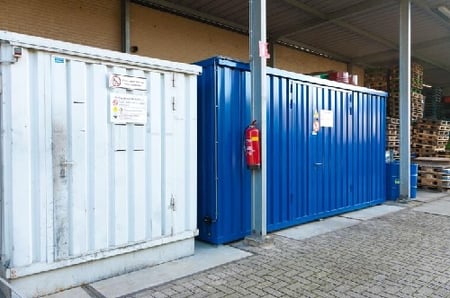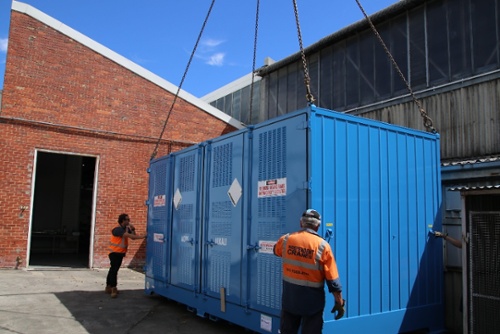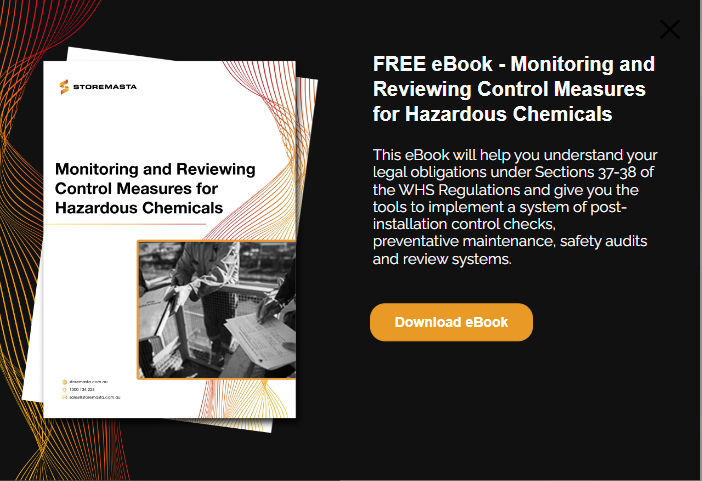There are many considerations to make when determining your dangerous goods and hazardous material storage needs. One of the key engineering controls available for outdoor chemical storage is a HAZMAT storage container. Alternatively known as dangerous goods containers or hazardous goods containers, a HAZMAT container provides specific safety measures for the class of chemical that you’re storing. In this blog, we look at 8 reasons you should use a HAZMAT storage container in your workplace if you want to reduce risks such as human harm, fire or environmental contamination.
But first, let’s explain what a HAZMAT container is and how it can help your business maintain chemical compliance.
What Do You Store in a HAZMAT Container?
Hazardous materials and dangerous goods are commonly found in a variety of workplaces. Across almost every industry, these substances are required to carry out daily business operations such as manufacturing, construction, mining and transport services.
Just as the name suggest, any material that’s considered hazardous to human health, property or the environment, can be deemed HAZMAT. This may include commonly found products such as petrol, enamel-based paints, pesticides or even corrosive cleaning products.
When considering your storage requirements for these dangerous goods, you must be aware of the specific risks that relate to the products that your business is carrying. That will determine the type of HAZMAT container that you will require for your chemicals.
You can identify the dangerous goods class of your chemicals by referring to the Safety Data Sheet (SDS) for each product. Along with the dangerous goods classification of your substances, the SDS will also outline the hazards associated with the product — and the requirements for safe handling and storage.
What Makes a Compliant Chemical Storage Container?
In Australia, you are required under WHS Regulations to provide a safe working environment that is free from hazards. For organisations that carry any type of dangerous goods, ensuring chemicals are properly stored is one of the most significant risk control measures that you need to consider.
Ensuring safe and compliant storage of dangerous goods in the workplace is not just a recommendation, it’s your legal obligation.
HAZMAT storage containers and dangerous goods containers are a popular option for businesses looking to store their chemicals in an outdoor environment. However, not all storage containers are created equal. When considering a HAZMAT storage container for your business, make sure you always check that it has been designed and built to meet the safety requirements of the relevant Australian Standard. If the container does not meet the requirements, it will not provide adequate risk control measures for your stored substances — and it could put your business at risk for non-compliance.
REMEMBER: It's important to install, use and maintain your chemical storage equipment to maintain safety and compliance. Find out more about your maintenance obligations by reading our blog.
Why Use A HAZMAT Storage Container?
Now that you have a better understanding of HAZMAT containers, we’ll highlight 8 reasons why it’s a good idea to use a DG container to store your hazardous substances onsite.
1. Fully Relocatable
As a fully relocatable chemical storage container, HAZMAT containers offer businesses flexibility due to their manoeuvrability. Whether your business has a large, secure yard or you’re working on a remote site, relocatable storage containers provide an all-in-one solution that can move along with your business and its changing needs. Look for containers that allow for easy transportation including features such as forklift channels, lifting lugs and locating plates.
Chemical storage containers are a fully relocatable storage solution.
2. Made for the Outdoor Environment
If your business has conducted a risk assessment and determined the need for outdoor chemical storage, then you need a container that is made to handle our harsh Australian conditions. DG containers are designed for the outdoor environment and offer impact protection for your chemicals with their heavy sheet steel design. If you are located in an area with more challenging weather conditions, you can opt for a HAZMAT container with additional features such as extra corrosion protection or a higher cyclone rating.
3. Range of Sizes and Capacities
Chemical storage containers, just like all dangerous goods storage options, come in a range of sizes and capacities to suit the needs of the individual business. Containers can range from 80 litre models to 20-foot dangerous goods containers that can hold up to 8,000 litres. When selecting your container, take into consideration the growing needs of your organisation. Larger storage containers usually provide greater value-for-money and will save you the extra expense of ordering further containers as your business grows over the years.
4. Cost-Effective Chemical Storage
While the Australian Standards lists a range of chemical stores that are appropriate for each class of dangerous goods, choosing an outdoor HAZMAT storage container is arguably one of the most cost-effective storage solutions. Choosing to have a store custom-built requires time and money, while purchasing a ready-made chemical storage container is a more affordable and convenient option. In addition to this, you won’t have the wait time associated with a custom build chemical store, so you can achieve a compliant workplace as soon as your container has been shipped and installed in your organisation.
5. Encourages Good Work Practices
Have you ever seen drums of chemicals left on a wooden pallet? Or perhaps tins of hazardous chemicals strewn around a workshop? If your staff have a dedicated storage space for their dangerous goods, they are more likely to follow safe handling and storage procedures. By encouraging good work practices with staff that handle hazardous chemicals, you’ll be minimising risks such as spills (due to inadequate spill containment), chemical burns (caused by dropped or damaged containers) and fire (which may occur if flammable chemicals are left near an ignition source).
Not only will a dangerous goods container reduce these risks, it will also decrease the likelihood of chemicals being lost, misused or stolen by staff or unathorised personnel.
6. Durability
Dangerous goods containers are made to last and constructed from non-combustible materials such as sheet steel. As they’ve been constructed for the outdoor environment, they are finished with a corrosion-resistant coating, such as 2-pack polyurethane primer and topcoat. When selecting your chemical storage container, make sure you consider how durable the container is. Look for storage containers that feature quality steel construction and corrosion protection so you can continue to use your container for decades to come. Remember, if your container suffers any type of damage, such as impact from a moving vehicle, contact your manufacturer or supplier to discuss options for part replacements or repairs.
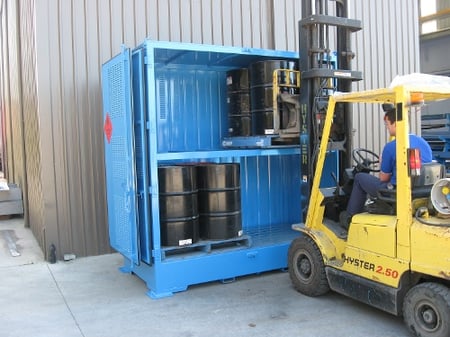
Any damage to a container, such as impact damage from a moving vehicle, must be noted immediately so a repair or part replacement can be organised.
7. Meeting Compliance Obligations
As we’ve mentioned earlier in this blog, to ensure that you’re receiving the highest standards of protection, you should check that your HAZMAT container has been designed and constructed to meet the requirements of the relevant Australian Standard.
Each class of dangerous goods has an applicable Standard which details all the features that must be present for a container to be deemed compliant. The list of requirements can be extensive and may include details such as spill containment capacity, ventilation, construction materials, door closing mechanisms and security features. If your container has been manufactured to meet the Australian Standards, all these risk control measures will be included in your cabinet — so you can store your hazardous chemicals in the safest of environments.
8. Risk Reduction
When you’re storing dangerous goods in the workplace, you have a legal obligation to provide a safe environment that is free from risks. And one of the most important considerations to make when conducting a risk assessment is how to store chemicals onsite without posing harm to people, property or the environment.
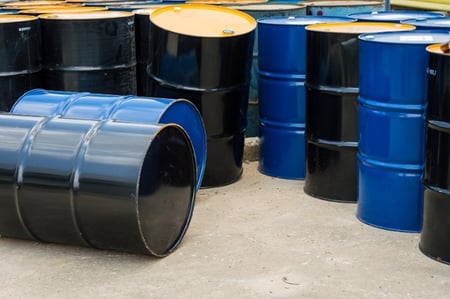
Your chemical storage container is designed to protect your staff, business and the local environment from risks, such as chemical spills.
HAZMAT storage containers are a key risk control measure that, if used and maintained correctly, can greatly minimise chemical risks. Containers that meet Australian Standards are equipped with features such as liquid-tight spill containment sumps, heat and fire protection, and natural ventilation systems. These control measures will help to reduce the risk of fire, asphyxiation, human harm and environmental contamination.
If chemicals aren’t stored in a dedicated, compliant storage space, there is a much greater chance that you will face a work health and safety issue in your organisation.
Buying A HAZMAT Storage Container
Thanks for reading our latest blog on the 8 reasons you should use a HAZMAT storage container in your workplace. Compliant storage is one of the most significant considerations for any business that carries any type of hazardous chemical or dangerous goods. However, choosing the right container for your business is just step 1 in the process of achieving chemical compliance.
If you’d like to learn more about how you can maintain compliance, we have an eBook that can help. Monitoring and Reviewing Control Measures For Hazardous Chemicals will introduce you to our 4-step risk management methodology and help you maintain your control measures, such as a HAZMAT storage container, so you can ensure safety and compliance. Get your free copy of our guide today by clicking on the image below.
Joining the team as a Dangerous Goods Storage Consultant, Melissa Hampton became Storemasta's Marketing Manager in late 2021. With extensive knowledge and experience in chemical compliance, Melissa is responsible for leading the Marketing team and helping shape their marketing strategy. In her spare time, you can find Melissa hiking, swimming and enjoying the great outdoors in beautiful north-west Tasmania.
